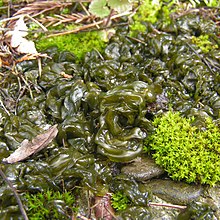- Nostoc agglutinans Meneghini ex Kützing, 1849
- Nostoc alatosporum Sant'Anna et al., 2007
- Nostoc album N.L.Gardner, 1927
- Nostoc alpinum Kützing, 1843
- Nostoc ambiceps C.-C.Jao, 1940
- Nostoc amplissimum Setchell, 1899
- Nostoc anisococcum Sprengel, 1827
- Nostoc antarcticum West & G.S.West, 1911
- Nostoc apuanum De Notaris, 1869
- Nostoc arctum Kützing, 1847
- Nostoc arenarium Desmazières, 1865
- Nostoc austinii H.C.Wood, 1873
- Nostoc belmonticum C.G.M.Archibald, 1967
- Nostoc bicalyptratum Skuja, 1937
- Nostoc bornetii Gain, 1911
- Nostoc borzioides S.Skinner & T.J.Entwisle, 2002
- Nostoc brittoni N.L.Gardner, 1927
- Nostoc caeruleum Lyngbye ex Bornet & Flahault, 1886
- Nostoc caladarium H.C.Wood, 1868
- Nostoc calcicola Brébisson ex Bornet & Flahault, 1886
- Nostoc carneum C.Agardh ex Bornet & Flahault, 1886
- Nostoc catenatum P.J.L.Dangeard, 1949
- Nostoc cesatii Balsamo, 1863
- Nostoc ciniflonum Tournefort ex Bornet, 1880
- Nostoc citrisporum Prasad & Mehrotra, 1976
- Nostoc coimbatorense Laloraya & Mitra, 1974
- Nostoc comminutum Kützing, 1850
- Nostoc commune Vaucher ex Bornet & Flahault, 1888
- Nostoc conglomeratum Hirose, 1962
- Nostoc copiosum Kogan & Jazkulieva, 1972
- Nostoc cordubense C.H.Prosperi, 1985
- Nostoc crassisporum Meneghini, 1837
- Nostoc crassisporum Geitler, 1933
- Nostoc cristatum Bailey, 1847
- Nostoc cycadae Maruyama & Fukushima, 1963
- Nostoc delpinoi Borzì, 1878
- Nostoc depressum H.C.Wood, 1873
- Nostoc desertorum Reháková & Johansen, 2007
- Nostoc diamorphoticum Itzigsohn, 1857
- Nostoc diplonema Montagne, 1857
- Nostoc disciforme F.E.Fritsch, 1912
- Nostoc edaphicum Kondrateva, 1962
- Nostoc edule Montagne & Berkeley ex Bornet & Flahault, 1886
- Nostoc elgonense Naumann, 1925
- Nostoc ellipsoideum N.L.Gardner, 1927
- Nostoc ellipsosporum Rabenhorst ex Bornet & Flahault, 1886
- Nostoc endophytum Bornet & Flahault, 1886
- Nostoc epilithicum Ercegovic, 1925
- Nostoc expansum Harvey & Bailey, 1851
- Nostoc filarzskyi G.De Toni, 1936
- Nostoc flagelliforme Harvey ex Molinari-Novoa, Calvo-Pérez & Guiry, 2016
- Nostoc flavicans Bory de Saint-Vincent, 1827
- Nostoc fluviatile Liljeblad, 1816
- Nostoc foliaceum Mougeot ex Bornet & Flahault, 1886
- Nostoc fonticola Brabez, 1941
- Nostoc fragiforme (Roth) Brébisson, 1870
- Nostoc fuscescens F.E.Fritsch, 1912
- Nostoc fuscum Kützing, 1863
- Nostoc gelatinosum Schousboe ex Bornet & Flahault, 1886
- Nostoc ghotgewadense G.R.Hegde & K.Somanna, 1992
- Nostoc glomeratum Kützing, 1850
- Nostoc granulare (Kützing) Rabenhorst, 1865
- Nostoc gregarium Thuret ex Kützing, 1849
- Nostoc gymnosphaericum Kützing, 1843
- Nostoc hatei S.C.Dixit, 1936
- Nostoc heterothrix Zeller, 1873
- Nostoc humifusum Carmichael ex Bornet & Flahault, 1886
- Nostoc hyalinum Roemer, 1845
- Nostoc hyalinum A.W.Bennett, 1886
- Nostoc hydrocoleoides Reinsch, 1876
- Nostoc imperfectum Schwabe & El Ayouty, 1966
- Nostoc indistinguendum Reháková & J.R.Johansen, 2007
- Nostoc insulare Borzì, 1907
- Nostoc interbryum Sant'Anna et al., 2007
- Nostoc intestinale G.S.An, 1992
- Nostoc inundatum Kützing, 1843
- Nostoc kihlmanii Lemmermann, 1900
- Nostoc koraiense G.S.An, 1990
- Nostoc krishnamurthyi S.Chandra, 2005
- Nostoc lacerum Kützing, 1843
- Nostoc lacunosum Montagne, 1850
- Nostoc lacustre Kützing, 1843
- Nostoc leptonema Reinsch, 1876
- Nostoc letestui Frémy, 1930
- Nostoc lichenoides Vaucher ex Reháková & J.R.Johansen, 2007
- Nostoc limosum Zeller, 1873
- Nostoc linckia Bornet ex Bornet & Flahault, 1886
- Nostoc littorale Kützing, 1842
- Nostoc locularis G.S.An, 1992
- Nostoc longstaffi F.E.Fritsch, 1912
- Nostoc lophotelos G.S.An, 1992
- Nostoc maculiforme Bornet & Flahault, 1888
- Nostoc mamillosum C.-C.Jao, 1940
- Nostoc maramorgellons Smith & Gerbaux, 2020
- Nostoc margaritaceum (Kützing) Rabenhorst, 1865
- Nostoc membranaceum N.L.Gardner, 1927
- Nostoc microscopicum Carmichael ex Bornet & Flahault, 1886
- Nostoc microtis Montagne, 1839
- Nostoc minimum Currey, 1858
- Nostoc minutissimum Kützing ex Bornet & Flahault, 1886
- Nostoc minutum Desmazières ex Bornet & Flahault, 1886
- Nostoc molle C.Agardh, 1827
- Nostoc mougeotii Brébisson ex Kützing, 1849
- Nostoc myriococcum Montagne, 1857
- Nostoc nivale Kützing, 1849
- Nostoc notarisii Franzoni, 1865
- Nostoc nylstromicum Claassen, 1961
- Nostoc opalinum A.W.Bennett, 1890
- Nostoc oryzae (F.E.Fritsch) J.Komárek & K.Anagnostidis, 1989
- Nostoc palmelioides Kützing
- Nostoc paludosum Kützing ex Bornet & Flahault, 1886
- Nostoc papillosum Kurz, 1870
- Nostoc paradoxum Welwitsch ex West & G.S.West, 1897
- Nostoc parietinum Rabenhorst, 1863
- Nostoc parmelioides Kützing ex Bornet & Flahault, 1886
- Nostoc parvulum C.-C.Jao, 1940
- Nostoc passerinianum Bornet & Thuret ex Bornet & Flahault, 1886
- Nostoc pellucidum Kützing, 1843
- Nostoc peloponnesiacum Kützing, 1849
- Nostoc peltigerae Letellier, 1918
- Nostoc polysaccum Reinsch, 1876
- Nostoc polysporum Reinsch, 1876
- Nostoc prismaticum Cesati, 1865
- Nostoc pruniforme C.Agardh ex Bornet & Flahault, 1886
- Nostoc pseudogelatinosum Claassen, 1961
- Nostoc punctatum H.C.Wood, 1873
- Nostoc punctiforme Hariot, 1891
- Nostoc purpurascens Kützing, 1843
- Nostoc purpureum Dickie, 1874
- Nostoc ramosum Ercegovic, 1925
- Nostoc repandum West & G.S.West, 1897
- Nostoc reticulatum Roussel, 1806
- Nostoc riabuschinskii Elenkin, 1914
- Nostoc rupestre Kützing, 1849
- Nostoc salsum Kützing, 1843
- Nostoc saxatile Zeller, 1873
- Nostoc segawae Okada, 1932
- Nostoc sergianum Borzì, 1892
- Nostoc shensiense C.C.Jao, 1948
- Nostoc simulans N.L.Gardner, 1927
- Nostoc sinuatum G.S.An, 1992
- Nostoc sphaericum Vaucher ex Bornet & Flahault, 1886
- Nostoc sphaeroides Kützing ex Bornet & Flahault, 1886
- Nostoc sphaerosporum N.L.Gardner, 1927
- Nostoc spinosum Tiwari, 1979
- Nostoc subtilissimum Reinsch, 1890
- Nostoc symbioticum F.V.Wettstein, 1915
- Nostoc tenax Thuret, 1874
- Nostoc tenuissimum (Kützing) Rabenhorst, 1865
- Nostoc thermophilum Vouk, 1916
- Nostoc thermotolerans Suradkar, 2017
- Nostoc tibeticum C.-C.Jao & Y.Y.Lee, 1974
- Nostoc torulosum Hirose, 1962
- Nostoc trentepohlii Mohr, 1806
- Nostoc tuberculosum Kützing, 1843
- Nostoc undulatum Archibald, 1967
- Nostoc vaillantii Behre, 1953
- Nostoc variegatum Moore, 1841
- Nostoc verrucosum Vaucher ex Bornet & Flahault, 1886
- Nostoc vesicarium A.B.Frank, 1886
- Nostoc viride Sant'Anna et al., 2007
- Nostoc vulgare Schrank, 1812
- Nostoc wartisporum Prasad et al., 1977
- Nostoc wichmannii Weber-van Bosse, 1913
- Nostoc willei N.L.Gardner, 1927
- Nostoc wollnyanum Richter, 1884
- Nostoc zetterstedtii Areschoug ex Bornet & Flahault, 1886
|

